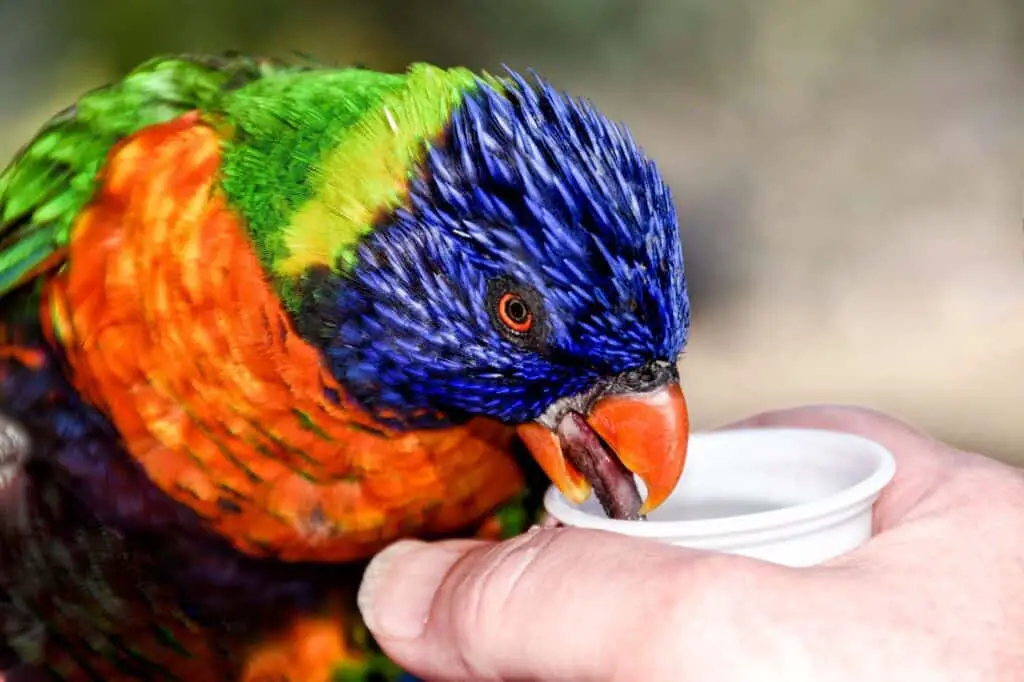The lorikeets and lories of Australasia are known to eat a specific diet. Over time, they adapted to this diet and developed a peculiar lorikeet tongue. Thus, it makes it harder to care for these animals in captivity.
Lorikeets have a long, flexible tongue that allows them to collect nectar and pollen from flowers. It’s made possible because of its tip, which has a brush-like appendage, so it can easily feed on natural food that would otherwise be unavailable.
Keep reading, because this article will tell you everything you need to know about lorikeets and their strange language.
What Is A Lorikeet? Let’s Get Acquainted
The name of the genus Trichoglossus refers to the various types of lorikeets, such as the rainbow lorikeets.
One of the best-known species is the rainbow lorikeet, bred in Australia and native. Other lorikeets live in places like New Guinea, Indonesia, and Borneo.
There are more than 20 different kinds of rainbow lorikeets living in the southwestern Pacific. These birds are generally about 5 ounces long and have vibrant patterns and colors on their chests, bellies, and necks. They also have black feet and red bills.
Lorikeets are the descendants of the Lories and the Loriini, two people from the same tribe. You can find these birds all around Australasia.
The vibrant purple-crowned lorikeets flock together in small groups to gather in dry scrubland areas of southern Australia to eat fruit and help pollinate a flowering mallee. These birds have dark purple caps on their heads and bright yellow and red cheek pads. The undersides of their wings are also adorned with green, blue, and red.
Lorikeets often nest in cavities in trees. Although pairs may sleep in the same hole, the female raises two to three eggs. These birds often flock together with other species that eat nectar and fruit. Nest in hollow trees and feed in the upper canopy. They then congregate in large groups at night.
What Is The Coolest Thing About A Lorikeet Tongue?

Lorikeets are known to drink nectar using their specialized tongues. These birds have small, hairlike structures known as papillae at the tip of their tongues. Also, the structures allow the birds to consume nectar and pollen while feeding. Due to their distinctive features, many call them brush-tongued parrots.
Lorikeets’ long, flexible tongues have changed over time to get to the nectar and pollen that flowers make. Its tip is shaped like a brush, which lets the species get the good stuff out of its favorite flowers, like eucalyptus.
What Is Special About The Tongue Of A Lory?
Lorikeets have tongues with brush-like tips to eat nectar and soft fruits better. The tongues they’ve evolved for this purpose allow them to sip nectar from the blossoms of over 5,000 plant species. Papillae (very fine hairs) at the tip of their tongues help them gather nectar and pollen.
Unlike other birds, lorikeets’ beaks are longer and thinner at the tip. This bird uses its beak to extract seeds from hard plants and pinecones. Its unique tongues are also used to scrape the fruits inside the bills.
Humans know how vital the tongue is, but most people think birds’ tongues don’t change sounds significantly. For instance, studies have shown that the tongue’s position can affect the vocalization of parrots.
Discovery Of Birds’ Taste Receptors
Before discovering birds’ taste receptors in the 1800s, people believed they lacked them. People eventually identified them during the 20th century.
Different animals, such as the chicken, the pigeon, and the parrot, have a variety of taste buds that are different from those found in humans. In birds, the taste buds reside in other parts. In these parrots, you’ll find them on the floor or roof of the mouth.
It is believed that the front of the tongue is hard and thorny, which is why that is not always the appearance of the birds’ tongues. Birds reportedly have various levels of gustatory sensitivity and taste different types of salt, sugar, brine, bitterness, and lipids.
Why Do Rainbow Lorikeets Lick?
Parrots use their tongues as a medium for touching. Like our fingers, these birds use their tongues to feel around their world. Since they use their beaks and tongues like their hands, they have difficulty developing a sense of taste. They are used to touching, which is why they have delicate nerve endings in their tongues.
How Do Lorikeets Eat?
Lorikeets are known to prioritize nectar. They get their food from the pollen of native plants like bottlebrushes and grevilleas. Aside from insects, they also consume fruits, berries, leafy greens, and other vegetables.
Lorikeets must get food that is equivalent to their natural diet. Since fresh food tends to lose nutrients and minerals quickly, it is essential to feed appropriately and water them regularly. This schedule can help keep them healthy and happy.
It would be best if you gave them their container to bathe in to keep the lorikeets from getting sick from splashes. Make sure that the cage is empty of water-related objects.
I created a comprehensive diet guide for Lorikeets that you may be interested in reading.
Likes Of Lorikeet
It is advisable to grow native plants if you want rainbow lorikeets to visit your garden. Also, lorikeets will appreciate a bird bath in your yard, where they can play and bathe their feathers after a meal.
Keep rainbow lorikeets on a diet of only fruit and vegetables; never feed them treats like biscuits, bread, or seeds. They might get used to these ways of getting food and lose their natural desire to look for food in the wild. When they eat seeds, it can hurt their mouth and tongue. Give them native plants to eat.
Bees and wasps eat nectar and pollen from local flowers like grevilleas, callistemons (bottlebrushes), and banksias. They get their strength from nectar, nectar, and feathers made from pollen, which is rich in protein. Fruits and tiny insects make up the rest of their diet. Wild lorikeets can easily construct nests in hollowed-out trees, one of their favorite locales.
Also, feeding the lorikeet the wrong food can damage their beak and tongue. It is why it’s essential to let them eat the seeds and grains from the wild. A lorikeet will often chase away a larger bird that’s hungry. Other animals, such as dogs, cats, and foxes, can also disturb lorikeets while feeding.
Precaution
Lorikeets need a balanced diet that includes processed foods like bread and biscuits. Their digestive system cannot handle processed sugar, so they prefer sweet treats. To minimize the possibility of nesting sites, you should cut down trees.
Also, feeding the lorikeet the wrong food can damage their beak and tongue. Let them eat the seeds and grains from the wild. A lorikeet will often chase away a larger bird that’s hungry. Other animals, such as dogs, cats, and foxes, can also disturb lorikeets while feeding.
Lorikeet Trivia
During the 1960s, several rainbow lorikeets were accidentally brought to Western Australia. The state’s Department of Regional Development thought ten or fewer of these birds got away or were set free.
The damage these birds do to agriculture is extensive. Their actions destroyed many crops, such as apples, pears, grapes, and stone fruit. They have also displaced native Perth species.
Also, in 2015, experts in Australia were puzzled by the appearance of rainbow lorikeets inside a feeding station stocked with meat products meant for predatory birds. The lorikeets kept an eye on the meat, which was strange because this species had never preferred meat before.
Other General Facts About Lorikeets
Here are some other general facts about lorikeets:
- The lorikeet is a loud bird that likes to cluster around trees. They need to be able to find each other to communicate. Their behavior can be very loud and boisterous.
- Lorikeets must be given the proper care for their health and well-being. They play and socialize with people, and they provide hours of entertainment. Unfortunately, if they are left alone, they can resort to destructive behaviors such as vocalization and plucking.
- Large lorikeets require a lot of room to live comfortably. They can fly through the air, and a life with sufficient time spent outside the cage is feasible. Playthings are also required for their confined space.
- The dietary requirements of lorikeets are specific. It means that people must be on top of things all the time. It is why experts do not recommend getting one as a first pet.
- The lorikeets have a territorial mentality. They are known to be aggressive towards other birds. If you do not train them to be kind, they may nip.
Conclusion
Lorikeets and lories in Australasia are known to consume a specific diet. Over time, they developed a peculiar tongue that made it hard to care for them in captivity.
Lorikeets can get nectar and pollen from their surroundings because their tongues are long and bendy. They drink nectar using their tongues, which have small papillae hairlike structures. These birds are called “brush-tongued lorikeets” due to their distinctive features.
- “Parrot.” Britannica. Accessed December 12, 2022. https://www.britannica.com/animal/parrot
- “Edwards Lorikeet.” Seaworld. Accessed December 12, 2022. https://seaworld.org/animals/facts/birds/edwards-lorikeet/
- “Lorikeets: Four things you didn’t know about them.”
- https://www.australiangeographic.com.au/topics/wildlife/2019/08/lorikeets-four-things-you-didnt-know-about-them/
- “My Parrots Lick My Fingers and Hands, Why?” Quora. Accessed December 12, 2022. https://www.quora.com/My-parrot-licks-my-fingers-and-hand-why
- “Lories and Lorikeets.”Scholarly Community Encyclopedia. Accessed December 12, 2022. https://encyclopedia.pub/entry/30571
- Johnston, Nancy. “Bird Tongues.” Golden Gate Audobon Society. December 17, 2014. https://goldengateaudubon.org/blog-posts/bird-tongues/




